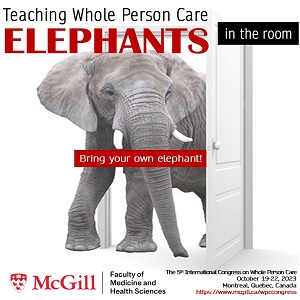The value of admissions characteristics for predicting the practice location of University of Saskatchewan College of Medicine graduates
DOI:
https://doi.org/10.36834/cmej.74288Abstract
Background: The physician workforce in Saskatchewan depends upon the retention of locally trained physicians. Characteristics collected at the time of medical school application may predict future practice location, but these associations have not been explored.
Methods: We identified the current practice location of University of Saskatchewan College of Medicine graduates who matriculated between 2000 and 2013 and extracted data from their admission applications including gender, age, high school, previous university, and current location at the time of application. We then conducted univariate and multivariate analyses to evaluate associations between these characteristics and rural- and Saskatchewan-based practice.
Results: We identified the current practice location of 1,001 (98.9%) of the graduates of the included cohorts. Attending a Saskatchewan high school (p < 0.001), a high school in a smaller population center (p < 0.01), and a Saskatchewan university (p < 0.001) were predictive of Saskatchewan-based practice. Attending a high school outside of Saskatchewan (p < 0.05), a high school in a smaller population center (p < 0.001), and living in a small population centre at the time of application (p < 0.05) were predictive of rural-based practice within or outside of Saskatchewan.
Conclusion: Demographic characteristics collected at time of medical school application are associated with future Saskatchewan- and rural-based practice. These findings will guide admissions policies in Saskatchewan and may inform admission practices of other medical schools.
Metrics
References
McGrail MR, Humphreys JS, Joyce CM. Nature of association between rural background and practice location: A comparison of general practitioners and specialists. BMC Health Serv Res. 2011;11. https://doi.org/10.1186/1472-6963-11-63
Mitra G, Gowans M, Wright B, Brenneis F, Scott I. Predictors of rural family medicine practice in Canada. Can Fam Physician. 2018;64(8):588-96.
Leonardson G, Lapierre R, Hollingsworth D. Factors predictive of physician location. J Med Educ. 1985;60(1):37-43. https://doi.org/10.1097/00001888-198501000-00006
Hughes S, Zweifler J, Schafer S, Smith MA, Athwal S, Blossom HJ. High school census tract information predicts practice in rural and minority communities. J Rural Heal [Internet]. 2005 Jul;21(3):228-32. https://doi.org/10.1111/j.1748-0361.2005.tb00087.x
Jarman BT, Cogbill TH, Mathiason MA, et al. Factors correlated with surgery resident choice to practice general surgery in a rural area. Vol. 66, JSE. 2009. p. 319-24. Available from: https://doi.org/10.1016/j.jsurg.2009.06.003.
Smith B, Muma RD, Burks L, Lavoie MM. Factors that influence physician assistant choice of practice location. J Am Acad Physician Assist. 2012;25(3):46-51. https://doi.org/10.1097/01720610-201203000-00010
Renner DM, Westfall JM, Wilroy LA, Ginde AA. The influence of loan repayment on rural healthcare provider recruitment and retention in Colorado. Rural Remote Health. 2010 Nov 9;10(4):1605. https://doi.org/10.22605/RRH1605
Anisimowicz Y, Miedema B, Easley J, Bowes AE. Factors influencing family medicine resident retention and newly graduated physicians ' first practice location. Journal of New Brunswick Studies. 2017;8:159-73. https://journals.lib.unb.ca/index.php/JNBS/article/view/25884
Royston PJ, Mathieson K, Leafman J, Ojan-Sheehan O. Medical student characteristics predictive of intent for rural practice. Rural Remote Health. 2012;12(3). https://doi.org/10.22605/RRH2107
MacQueen IT, Maggard-Gibbons M, Capra G, et al. Recruiting rural healthcare providers today: a systematic review of training program success and determinants of geographic choices. J Gen Intern Med. 2018 Feb 1;33(2):191-9. https://doi.org/10.1007/s11606-017-4210-z
Kimball EB, Crouse BJ. Perspectives of female physicians practicing in rural Wisconsin. Wis Med J. 2007;106(5):256-9.
Glasser M, MacDowell M, Hunsaker M, et al. Factors and outcomes in primary care physician retention in rural areas. South African Fam Pract. 2010;52(4):336-40. https://doi.org/10.1080/20786204.2010.10874002
Wade ME, Brokaw JJ, Zollinger TW, et al. Influence of hometown on family physicians' choice to practice in rural settings. Fam Med. 2007;39(4):248-54.
Jones M, Humphreys J, Prideaux D. Predicting medical students' intentions to take up rural practice after graduation. Med Educ. 2009 Oct;43(10):1001-9. https://doi.org/10.1111/j.1365-2923.2009.03506.x
Shannon CK, Jackson J. Validity of medical student questionnaire data in prediction of rural practice choice and its association with service orientation. J Rural Heal. 2015 Sep;31(4):373-81. http://doi.wiley.com/10.1111/jrh.12123
Canadian Institutes of Health Research, Canada N. Tri-Council Policy Statment - Ethical Conduct for Research Involving Humans [Internet]. 2014 p. 93. Available from: www.pre.ethics.gc.ca
Statistics Canada. Population Centre and Rural Area Classification 2016. 2017.
Rabinowitz HK, Diamond JJ, Markham FW, Santana AJ. The relationship between entering medical studentsʼ backgrounds and career plans and their rural practice outcomes three decades later. Acad Med. 2012 Apr;87(4):493-7 https://doi.org/10.1097/ACM.0b013e3182488c06
Budhathoki SS, Zwanikken PAC, Pokharel PK, Scherpbier AJ. Factors influencing medical students' motivation to practise in rural areas in low-income and middle-income countries: a systematic review. Vol. 7, BMJ Open. BMJ Publishing Group; 2017. https://doi.org/10.1136/bmjopen-2016-013501
Crump WJ, Fricker RS, Ziegler CH, Wiegman DL. Increasing the rural physician workforce: a potential role for small rural medical school campuses. J Rural Heal. 2016 Jun [cited 2020 Jan 28];32(3):254-9. https://doi.org/10.1111/jrh.12156
Rabinowitz HK, Diamond JJ, Markham FW, Rabinowitz C. Long-term retention of graduates from a program to increase the supply of rural family physicians. Acad Med. 2005;80(8):728-32. https://doi.org/10.1097/00001888-200508000-00004
Greer T, Kost A, Evans DV, et al. The WWAMI Targeted Rural Underserved Track (TRUST) program: an innovative response to rural physician workforce shortages. Acad Med. 2016;91(1):65-9. https://doi.org/10.1097/ACM.0000000000000807
Henry JA, Edwards BJ, Crotty B. Why do medical graduates choose rural careers? Rural Remote Health. 2009;9(1):1083. https://doi.org/10.22605/RRH1083
Quinn KJ, Kane KY, Stevermer JJ, et al. Influencing residency choice and practice location through a longitudinal rural pipeline program. Acad Med. 2011;86(11):1397-406. https://doi.org/10.1097/ACM.0b013e318230653f
Mian O, Hogenbirk JC, Marsh DC, Prowse O, Cain M, Warry W. Tracking Indigenous Applicants Through the Admissions Process of a Socially Accountable Medical School. Vol. 94, Acad Med. 2019. 1211-1219 p. https://doi.org/10.1097/ACM.0000000000002636
Downloads
Published
How to Cite
Issue
Section
License
Copyright (c) 2022 Avery Ironside, Brent Thoma, Krista Trinder, Sherrill Bueckert, Tara Lee, Trustin Domes

This work is licensed under a Creative Commons Attribution-NonCommercial-NoDerivatives 4.0 International License.
Submission of an original manuscript to the Canadian Medical Education Journal will be taken to mean that it represents original work not previously published, that it is not being considered elsewhere for publication. If accepted for publication, it will be published online and it will not be published elsewhere in the same form, for commercial purposes, in any language, without the consent of the publisher.
Authors who publish in the Canadian Medical Education Journal agree to release their articles under the Creative Commons Attribution-Noncommercial-No Derivative Works 4.0 Canada Licence. This licence allows anyone to copy and distribute the article for non-commercial purposes provided that appropriate attribution is given. For details of the rights an author grants users of their work, please see the licence summary and the full licence.












